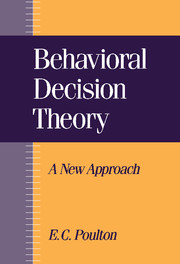Book contents
- Frontmatter
- Acknowledgments
- Contents
- Preface
- Chapter 1 Outline of heuristics and biases
- Chapter 2 Practical techniques
- Chapter 3 Apparent overconfidence
- Chapter 4 Hindsight bias
- Chapter 5 Small sample fallacy
- Chapter 6 Conjunction fallacy
- Chapter 7 Regression fallacy
- Chapter 8 Base rate neglect
- Chapter 9 Availability and simulation fallacies
- Chapter 10 Anchoring and adjustment biases
- Chapter 11 Expected utility fallacy
- Chapter 12 Bias by frames
- Chapter 13 Simple biases accompanying complex biases
- Chapter 14 Problem questions
- Chapter 15 Training
- Chapter 16 Overview
- References
- Index
Chapter 6 - Conjunction fallacy
Published online by Cambridge University Press: 06 July 2010
- Frontmatter
- Acknowledgments
- Contents
- Preface
- Chapter 1 Outline of heuristics and biases
- Chapter 2 Practical techniques
- Chapter 3 Apparent overconfidence
- Chapter 4 Hindsight bias
- Chapter 5 Small sample fallacy
- Chapter 6 Conjunction fallacy
- Chapter 7 Regression fallacy
- Chapter 8 Base rate neglect
- Chapter 9 Availability and simulation fallacies
- Chapter 10 Anchoring and adjustment biases
- Chapter 11 Expected utility fallacy
- Chapter 12 Bias by frames
- Chapter 13 Simple biases accompanying complex biases
- Chapter 14 Problem questions
- Chapter 15 Training
- Chapter 16 Overview
- References
- Index
Summary
Summary
The conjunction fallacy or conjunction effect involves judging a compound event to be more probable than one of its 2 component events. Tversky and Kahneman like to attribute the conjunction fallacy to their heuristic of judgment by similarity or representativeness, instead of by probability. However, the fallacy can result from averaging the probabilities or their ranks, instead of using the normative rule of multiplying the probabilities. The conjunction fallacy can also result from failing to detect a binary sequence hidden in a longer sequence, and from failing to invert the conventional probability.
The causal conjunction fallacy occurs in forecasting and in courts of law. The fallacy involves judging an event to be more probable when it is combined with a plausible cause. The fallacy can be produced by judging p(event/cause) instead of p(event & cause). In theory, the conjunction fallacy or conjunction effect may be an appropriate response. This can happen when one of a number of possible alternatives is known to be correct, and the student has to discover which alternative it is by combining conjunctive evidence, using the Bayes method. Versions of both the conjunction fallacy and the dual conjunction fallacy can be accounted for in this way, although it is very unlikely that untrained students would know any of this.
The incidence of the conjunction fallacy can be reduced by asking for a direct comparison between the 2 key alternatives, instead of asking for all the alternatives to be ranked by probability; by changing the question from ranking probabilities or asking for percentages to asking for numbers out of 100; by calling attention to a causal conjunction; and by training in probability theory and statistics.
Information
- Type
- Chapter
- Information
- Behavioral Decision TheoryA New Approach, pp. 105 - 126Publisher: Cambridge University PressPrint publication year: 1994
